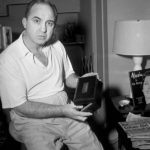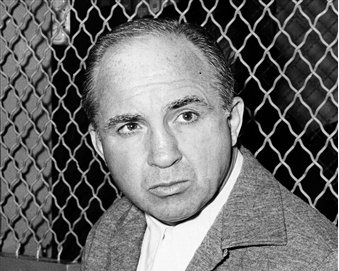Mickey Cohen was the mob king of Los Angeles, the Jewish gangster who once ran the Hollywood underworld. Renowned for his violent temper and tabloid exploits, he was one of the premier gangsters on the West Coast, and worked with such high-profile names as Benjamin “Bugsy” Siegel and Al Capone.
Meyer Harris Cohen was born in a Jewish neighborhood of Brooklyn on September 4, 1913. His father died when he was a year old and his mother, a Ukrainian Orthodox Jew, raised him. They lived in the Brownsville neighborhood for a few years, then moved to Los Angeles.
It was in the Boyle Heights neighborhood that Cohen got his start in petty crime. His brothers ran a drug store during Prohibition, and they showed him how to make bootleg liquor there. At the age of nine, Cohen robbed the box office of the Columbia Theatre with a cudgel and wound up in reform school. By the time he was 10, he’d been there twice.
Cohen was a tough guy, and he spent much of his youth in the boxing ring, dueling in illegal prizefights. At 15 he ran away to Cleveland to train as a boxer. He fought several times as a featherweight between 1930 and 1933, with a mixed record. During one fight, he tried to bite an ear off his opponent.
Cohen made his first Mafia ties in Cleveland, where he hired on with Lou Rothkopf, associate of Cleveland gang leader Moe Dalitz. He then moved to New York and worked with mobsters such as Tommy Dioguardi and Owney Madden.
From there he went to Chicago, where he was hired by Al Capone’s Outfit at the height of Prohibition. It’s possible the two met, but not certain. In either even, Cohen was an enforcer for Capone and ran a gambling ring for him. And he worked with Capone’s brother Mattie.
Cohen had several scrapes while he was in Chicago, spending a short time in prison for the deaths of several mobsters during a card game. And a dispute with another gambler forced him to leave the city in 1937.
Back in Cleveland, there wasn’t much for Cohen to do. So he was sent west to work with Bugsy Siegel in Los Angeles. Together they muscled control of the West Coast for their East Coast Mafia bosses.
Siegel and Cohen had a lot in common. They were both flashy Jewish climbers from Brooklyn with violent mean streaks. But Siegel ranked higher than Cohen in the eyes of the Italian Mafia they both depended upon for income.
Bugsy was involved in numerous rackets in Los Angeles and Las Vegas – gambling, prostitution, drug trafficking – and he was looking to expand into legal casinos. With Cohen’s help, he secured a majority stake for the mob in the Flamingo Hotel & Casino, a project underway on the Strip just outside Las Vegas.
Cohen took over bookmaking at the casino and set up a race wire, an operation that delivered instant horse race results to bookies. He was a major player on the West Coast, working with Siegel in Nevada and Los Angeles boss Jack Dragna in California. Siegel was in charge.
But things began to sour in Las Vegas. Siegel’s pet project, the Flamingo, lost money before it even opened. The premier was a flop.

Eventually the place started bringing in a profit for its mob owners, but they already suspected Bugsy was skimming cash from the tables.
Siegel was shot to death through the window of his girlfriend’s Beverly Hills home in 1947. Cohen, a close friend, allegedly stormed into the hotel where he believed the assassins were staying and fired two guns into the ceiling. When they didn’t answer his challenge, he fled before the police could arrive.
Siegel’s bosses in Chicago and New York promptly assumed control of the Flamingo, and Cohen was put in charge of Mafia operations in L.A. Over the years he earned a name for himself in the city and a place as a Hollywood celebrity.
Cohen’s criminal operations in L.A. brought him into contact with the city’s major players. Almost the entire Rat Pack kissed his ring, as did Robert Mitchum, Jerry Lewis and other performers. Cohen hired enforcer Johnny Stompanato as his bodyguard while Stompanato was having an affair with actress Lana Turner; the star’s daughter eventually killed Stampanato in an act of justifiable homicide.
The limelight brought attention from unwelcome corners as well. Investigators looking into Dragna’s operations also dug into Cohen’s activities. In the early 1950s, he became a focus of the U.S. Senate’s Kefauver Committee on organized crime.
Dragna refused to accept Cohen’s placement atop the underworld hierarchy in L.A., and open gang warfare erupted in the city. Attempts on Cohen’s life became increasingly common. His enemies bombed his home, so he armed it to the teeth with guns, floodlights and alarms.
Dragna’s assassination attempts never worked, and the criminal charges against Cohen never seemed to stick. But he was finally snared when we was sentenced to four years in prison in 1951 for tax evasion, a consequence of the Kevfauver hearings. He was released in 1955 and went right back to his old ways.

From that point on, however, he was a bona fide mob celebrity. He wore flashy custom-tailored suits, ran scores of legitimate businesses and casinos, and appeared on television in 1957 with Mike Wallace. He also extorted some of the stars who helped make him famous, blackmailing them with proof of their affairs and other secrets.
But his luck didn’t last as long this time. In 1961 he was convicted of tax evasion again, this time with the personal weight of Attorney General Robert F. Kennedy behind the prosecution. The sentence was serious: 15 years, breaking the record for a tax conviction set by Capone three decades earlier. And Cohen served most of it, 11 years, including time on Alcatraz.
Cohen was released from the Atlanta Federal Penitentiary in 1972, suffering from stomach cancer and partial paralysis caused by an assault in prison. He underwent surgery and resumed his public appearances. He died four years later, on July 29, 1976, and is buried at Hillside Memorial Park Cemetery in Culver City, Cal.

Essays like this are so important to broadening people’s horizons.
ALWAYS ENJOYED THE MEETING AND READING ABOUT THE MAFIA, THE ORGANIZATION AND COSA NOSTRA VERY INTERESTING HOW THEY BECAME SO POWERFUL PROHIBITION WAS THE REASON
Where can I find more about his larger family I brothers, brother kids etc.
Mickey was always a gentleman in my presence..he spent much time with my father.. they had slot in common.